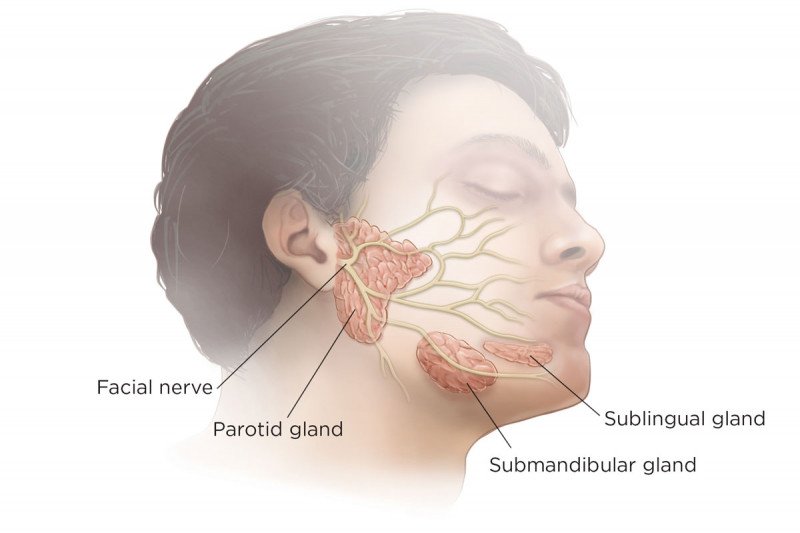Salivary Gland
Salivary Gland- The saliva is secreted by three pairs of major (larger) salivary glands and some minor (small) salivary glands.
Major glands are-
- Parotid glands
- Submaxillary or submandibular glands
- Sublingual glands.

1. Parotid glands-
Parotid glands are the largest of all salivary glands, situated at the side of the face just below and in front of the ear. Each gland weighs about 20 to 30 g in adults.
Secretions from these glands are emptied into the oral cavity by Stensen duct. This duct is about 35 mm to 40 mm long and opens inside the cheek against the upper second molar tooth.
2. Submaxillary glands-
Submaxillary glands or submandibular glands are located in submaxillary triangle, medial to mandible. Each gland weighs about 8 to 10 g. Saliva from these glands is emptied into the oral cavity by Wharton duct, which is about 40 mm long. The duct opens at the side of frenulum of tongue, by means of a small opening on the summit of papilla called Caruncula Sublingualis.
3. Sublingual glands
Sublingual glands are the smallest salivary glands situated in the mucosa at the floor of the mouth. Each gland weighs about 2 to 3 g. Saliva from these glands is poured into 5 to 15 small ducts called ducts of Rivinus.
These ducts open on small papillae beneath the tongue. One of the ducts is larger and it is called Bartholin duct. It drains the anterior part of the gland and opens on caruncula sublingualis near the opening of submaxillary duct.
| Enzyme | Source of secretion | Activator | Action |
| Salivary amylase | All salivary glands | Acid medium | Converts starch into maltose |
| Maltase | Major salivary glands | Acid medium | Converts maltose into glucose |
| Lingual lipase | Lingual glands | Acid medium | Converts triglycerides of milk fat into fatty acids and diacylglycerol |
Minor Salivary Gland-
- Lingual Mucus Glands
Lingual mucus glands are situated in posterior one third of the tongue, behind circumvallate papillae and at the tip and margins of tongue.
- Lingual Serous Glands
Lingual serous glands are located near circumvallate papillae and filiform papillae.
- Buccal Glands
Buccal glands or molar glands are present between the mucus membrane and buccinator muscle. Four to five of these are larger and situated outside buccinator, around the terminal part of parotid duct.
- Labial Glands
Labial glands are situated beneath the mucus membrane around the orifice of mouth.
- Palatal Glands
Palatal glands are found beneath the mucus membrane of the soft palate.
Salivary glands are classified into three types, based on the type of secretion-
1. Serous Glands
Serous glands are mainly made up of serous cells. These glands secrete thin and watery saliva. Parotid glands and lingual serous glands are the serous glands.
2. Mucus Glands
Mucus glands are mainly made up of mucus cells. These glands secrete thick, viscous saliva with high mucin content. Lingual mucus glands, buccal glands and palatal glands belong to this type.
3. Mixed Glands
Mixed glands are made up of both serous and mucus cells. Submandibular, sublingual and labial glands are the mixed glands.
Property of Saliva.
Volume-
- 1000 mL to 1500 mL of saliva is secreted per day and it is approximately about 1 mL/minute.
- Reaction- Mixed saliva from all the glands is slightly acidic with pH of 6.35 to 6.85 3.
- Specific gravity- It ranges between 1.002 and 1.012 4.
- Tonicity- Saliva is hypotonic to plasma.
Composition of saliva-
Mixed saliva contains 99.5% water and 0.5% solids.
Function saliva-
- Preparation of food for Swallowing- The mucus membrane of mouth is also moistened by saliva. It facilitates chewing. By the movement of tongue, the moistened and masticated food is rolled into a bolus. Mucin of saliva lubricates the bolus and facilitates swallowing.
- Appreciation of Taste- Taste is a chemical sensation. By its solvent action, saliva dissolves the solid food substances, so that the dissolved substances can stimulate the taste buds. The stimulated taste buds recognize the taste.
- Digestive Function- Salivary amylase is a carbohydrate-digesting (amylolytic) enzyme. It acts on cooked or boiled starch and converts it into dextrin and maltose. Though starch digestion starts in the mouth, major part of it occurs in stomach because, food stays only for a short time in the mouth.
pH necessary for the activation of saliv ary amylase is 6. Salivary amylase cannot act on cellulose.
Maltase -Maltase is present only in traces in human saliva and it converts maltose into glucose.
Lipase- Lingual lipase is a lipid-digesting (lipolytic) enzyme. It is secreted from serous glands situated on the posterior aspect of tongue. It digests milk fats (pre-emulsified fats).
- Cleansing and Protective function-
- Due to the constant secretion of saliva, the mouth and teeth are rinsed and kept free off food debris, shed epithelial cells and foreign particles. In this way, saliva prevents bacterial growth by removing materials, which may serve as culture media for the bacterial growth.
- Enzyme lysozyme of saliva kills some bacteria such as staphylococcus, streptococcus and brucella.
- Lactoferrin of saliva also has antimicrobial property.
- Proline-rich proteins and lactoferrin protect the teeth by stimulating enamel formation.
- Proline-rich proteins present in saliva possess antimicrobial property and neutralize the toxic substances such as tannins. Tannins are present in many food substances including fruits.
- Immunoglobulin IgA in saliva also has antibacterial and antiviral actions.
- Mucin present in the saliva protects the mouth by lubricating the mucus membrane of mouth.